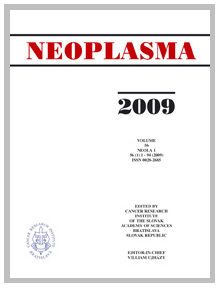Journal info
|
||
Select Journal
Journals
Bratislava Medical Journal Ekologia - Ecology Endocrine Regulations General Physiology and Biophysics Neoplasma 2025 Ahead of print 2024 2023 2022 2021 2020 2019 2018 2016 2017 2015 2014 2013 2012 2011 2010 2009 2008 2007 2006 2005 2004 2003 Acta Virologica Studia Psychologica Cardiology Letters Psychológia a patopsych. dieťaťa Kovove Materialy-Metallic Materials Slovenská hudba 2025Webshop Cart
Your Cart is currently empty.
Info: Your browser does not accept cookies. To put products into your cart and purchase them you need to enable cookies.
Neoplasma Vol.70, No.1, p. 46–57, 2023 |
||
| Title: Sestrin2 mediates FOXM1 expression to block the EMT process in non-small cell lung cancer through the AMPK/YAP pathway | ||
| Author: Yuan-Li Wang, Qi Wang, Hua Li, Cai-Chun Wang, Yan-Lin Ma, Zhong Han | ||
| Abstract: Non-small cell lung cancer (NSCLC) is characterized by high incidence and mortality, severely threatening human health. The infinite growth and metastasis of NSCLC cells result in a poor prognosis. Therefore, our study was to investigate the mechanism of Sestrin2 on the epithelial-mesenchymal transition (EMT) process of NSCLC cells. Human embryonic lung fibroblasts, NSCLC cell lines, and nude mice were experimental subjects in this study. qRT-PCR and western blot were performed to evaluate the mRNA and protein expression of genes. CCK-8 and EdU assay were conducted to detect cell proliferation. The scratch test and Transwell assay were applied to examine cell migration and invasion. The bioinformatics analysis and Co-IP assay were employed to predict and consolidate the interaction between YAP and TEAD. We found the expression of Sestrin2 was declined but the expression of YAP was elevated in NSCLC cells. Sestrin2 sufficiency or YAP silencing could effectively impair cell growth and metastasis. Mechanistically, YAP interacted with TEAD to enhance FOXM1 expression. Additionally, the elevation of FOXM1 abolished the inhibitory influences of Sestrin2 sufficiency on NSCLC cell growth, invasion, and EMT process. Eventually, Sestrin2 elevation attenuated tumor growth in mice via modulation of the AMPK/YAP/FOXM1 axis, which was reversed by FOXM1 overexpression. Our consequences suggested Sestrin2 could inhibit the activation of YAP via prompting AMPK phosphorylation and then suppress FOXM1 expression through the interplay between YAP and TEAD to impair the capacities of NSCLC cell proliferation, migration, invasion, and EMT. This study provided a novel mechanism of Sestrin2 in NSCLC. |
||
| Keywords: Sestrin2; YAP; FOXM1; EMT; non-small cell lung cancer | ||
| Published online: 09-Jan-2023 | ||
| Year: 2023, Volume: 70, Issue: 1 | Page From: 46, Page To: 57 | |
| doi:10.4149/neo_2022_220711N705 |
||
|
|
 download file download file |
|

